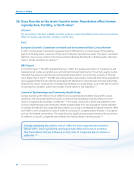24 l © 2025 American Dental Association
Section 1: Effectiveness and Benefits
Oral health disparities exist in the United States and have been documented through extensive studies
and reviews.48,127,128 Despite the fact that millions of people in the United States enjoy good dental
health, disparities exist for many racial and ethnic groups, as well as by socioeconomic status, sex,
age, and geographic location.129 Water fluoridation helps to reduce the disparities in oral health at
the community level as it benefits all residents served by community water supplies.
In a 2015 Surgeon General’s Perspective,54 Surgeon General Dr. Vivek Murthy noted, “…it is one
of the most cost-effective, equitable, and safe measures communities can take to prevent tooth
decay and improve oral health.”
Additional information on this topic can be found in the Public Policy Section, Question 59.
Dental cavities are largely preventable with good oral hygiene (brushing and flossing) and preventive
care such as routine dental exams, cleanings, topical fluoride applications, dental sealants, and
community water fluoridation. Established by HHS, Healthy People 203055 provides a science-based,
comprehensive set of ambitious yet achievable 10-year national objectives for improving the health
of the public. The current Healthy People 2030 objectives55 include an oral health objective to
expand the fluoridation of public water supplies. Objective OH-11 states that at least 77.1% of the US
population served by community water systems should be receiving the benefits of water fluoridated
at recommended levels by the year 2030.56 Data from the CDC indicate that, in 2022, 72.3% of the
US population on public water systems, or a total of 209.1 million people, had access to fluoridated
water.57 Conversely, approximately 27% or more than 78 million people on public water systems do
not receive the decay-preventing benefits of fluoridation.
11. Do adults benefit from fluoridation?
Answer
Yes. Fluoridation plays a protective role against tooth decay throughout life, benefiting both
children and adults.
Fact
While the early fluoridation trials were not designed to study the possible benefits fluoridation might
have for adults, by the mid-1950s, it became evident from the results of the first fluoridation trial
in Grand Rapids, Michigan, that the beneficial effects of fluoridation were not confined to children
drinking the fluoridated water from birth. The fact that a reduction in tooth decay was observed for
teeth that had already been calcified or were erupted when fluoridation was started indicated that a
beneficial effect could be gained by older age groups.23,130 Today, it is understood that the maximum
reduction in tooth decay occurs when fluoride has been incorporated into the tooth during formation
and when it also is available at the tooth surface during demineralization and remineralization. Fluoride
enhances the remineralization of teeth and inhibits bacterial growth and acid production by the bacteria
in the plaque. Fluoridation works topically after teeth have erupted and systemically while teeth are
forming to prevent tooth decay.39,76,79,81,83
Fluoride and minerals, including calcium and phosphate, are present in saliva74,76 and are stored in
dental plaque (a soft, sticky biofilm that is constantly forming on teeth). To halt the formation of tooth
decay or rebuild tooth surfaces, fluoride must be constantly present in low concentrations in saliva and
the plaque biofilm.74 Frequent exposure to small amounts of fluoride, such as that which occurs when
drinking fluoridated water, helps maintain the reservoir of available fluoride in saliva and plaque to resist
Section 1: Effectiveness and Benefits
Oral health disparities exist in the United States and have been documented through extensive studies
and reviews.48,127,128 Despite the fact that millions of people in the United States enjoy good dental
health, disparities exist for many racial and ethnic groups, as well as by socioeconomic status, sex,
age, and geographic location.129 Water fluoridation helps to reduce the disparities in oral health at
the community level as it benefits all residents served by community water supplies.
In a 2015 Surgeon General’s Perspective,54 Surgeon General Dr. Vivek Murthy noted, “…it is one
of the most cost-effective, equitable, and safe measures communities can take to prevent tooth
decay and improve oral health.”
Additional information on this topic can be found in the Public Policy Section, Question 59.
Dental cavities are largely preventable with good oral hygiene (brushing and flossing) and preventive
care such as routine dental exams, cleanings, topical fluoride applications, dental sealants, and
community water fluoridation. Established by HHS, Healthy People 203055 provides a science-based,
comprehensive set of ambitious yet achievable 10-year national objectives for improving the health
of the public. The current Healthy People 2030 objectives55 include an oral health objective to
expand the fluoridation of public water supplies. Objective OH-11 states that at least 77.1% of the US
population served by community water systems should be receiving the benefits of water fluoridated
at recommended levels by the year 2030.56 Data from the CDC indicate that, in 2022, 72.3% of the
US population on public water systems, or a total of 209.1 million people, had access to fluoridated
water.57 Conversely, approximately 27% or more than 78 million people on public water systems do
not receive the decay-preventing benefits of fluoridation.
11. Do adults benefit from fluoridation?
Answer
Yes. Fluoridation plays a protective role against tooth decay throughout life, benefiting both
children and adults.
Fact
While the early fluoridation trials were not designed to study the possible benefits fluoridation might
have for adults, by the mid-1950s, it became evident from the results of the first fluoridation trial
in Grand Rapids, Michigan, that the beneficial effects of fluoridation were not confined to children
drinking the fluoridated water from birth. The fact that a reduction in tooth decay was observed for
teeth that had already been calcified or were erupted when fluoridation was started indicated that a
beneficial effect could be gained by older age groups.23,130 Today, it is understood that the maximum
reduction in tooth decay occurs when fluoride has been incorporated into the tooth during formation
and when it also is available at the tooth surface during demineralization and remineralization. Fluoride
enhances the remineralization of teeth and inhibits bacterial growth and acid production by the bacteria
in the plaque. Fluoridation works topically after teeth have erupted and systemically while teeth are
forming to prevent tooth decay.39,76,79,81,83
Fluoride and minerals, including calcium and phosphate, are present in saliva74,76 and are stored in
dental plaque (a soft, sticky biofilm that is constantly forming on teeth). To halt the formation of tooth
decay or rebuild tooth surfaces, fluoride must be constantly present in low concentrations in saliva and
the plaque biofilm.74 Frequent exposure to small amounts of fluoride, such as that which occurs when
drinking fluoridated water, helps maintain the reservoir of available fluoride in saliva and plaque to resist
















































































































































